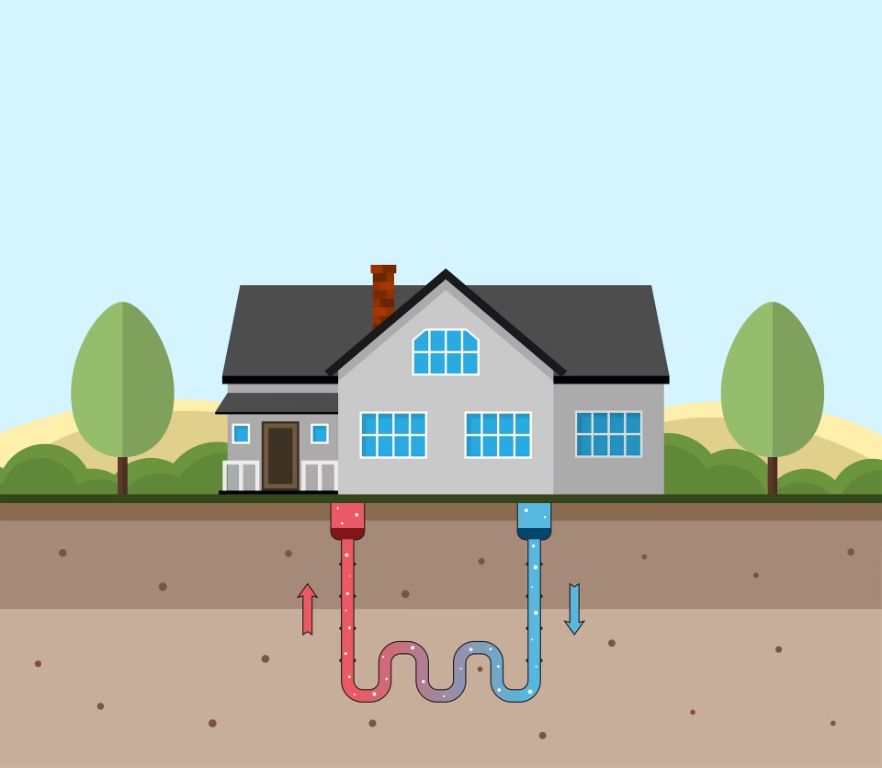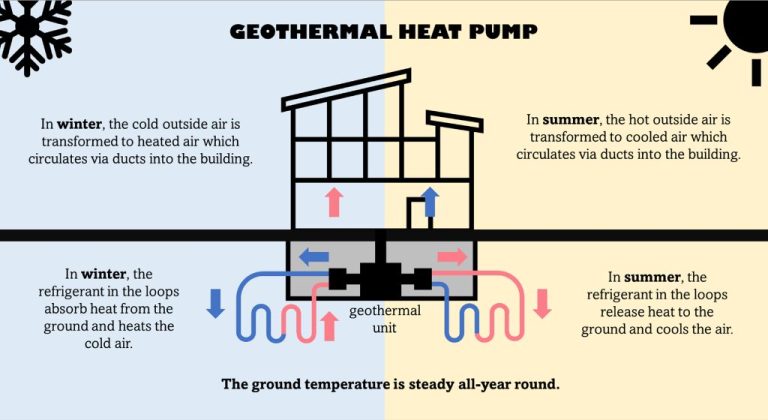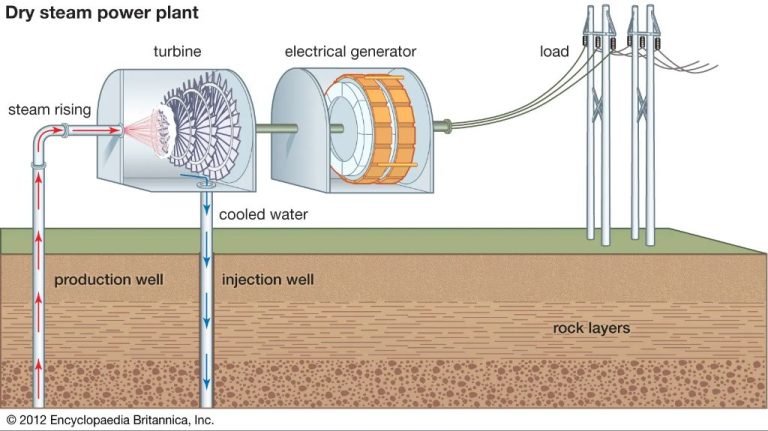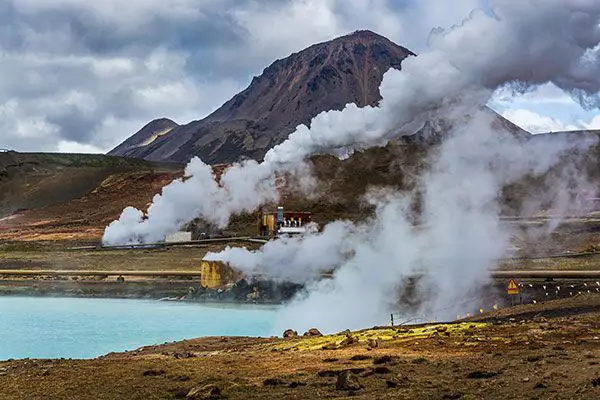How Can I Get Geothermal Energy At Home?
What is geothermal energy?

Geothermal energy is heat energy generated and stored underneath the Earth’s surface. It is a clean, renewable source of energy that taps into the natural heat from the Earth’s core to produce hot water and steam for heating homes and generating electricity (www.eia.gov/energyexplained/geothermal).
There are three main types of geothermal energy systems:
- Direct geothermal – uses hot water reservoirs near the Earth’s surface for district heating systems or electricity generation.
- Geothermal heat pumps – pump water or antifreeze through pipes buried near the Earth’s surface to heat and cool buildings.
- Enhanced geothermal systems – inject water into hot dry rocks deep below the Earth’s surface, which is heated and returned to the surface as hot water.
Geothermal energy works by tapping into underground reservoirs of steam and hot water. These reservoirs are often found along plate boundaries and volcanic hot spots where magma comes close to the Earth’s surface. Wells can be drilled into these underground reservoirs to pump the heated water or steam to the surface for direct heating purposes or to power electric generators (www.twi-global.com/technical-knowledge/faqs/geothermal-energy).
Benefits of geothermal energy
Geothermal energy provides several important benefits that make it an attractive renewable energy source for homes:
It is renewable – geothermal energy taps into the Earth’s natural heat that is constantly being generated in the core, so it will not run out like fossil fuels. The geothermal reservoir is replenished over time.
It can lead to reduced energy bills – once installed, geothermal systems provide heating and cooling very efficiently, resulting in much lower electricity costs compared to conventional HVAC systems (source).
The systems are energy efficient because they move existing heat rather than having to generate it entirely. This makes them up to 40% more efficient than even the most efficient gas furnace (source).
Geothermal systems require very low maintenance since they have few moving parts that can break down. Annual maintenance is minimal compared to other HVAC systems.
Types of geothermal systems for homes
There are a few main types of geothermal systems used for residential heating and cooling:
Geothermal heat pumps
Geothermal heat pumps, also known as ground source heat pumps, utilize pipes buried underground to transfer heat between the ground and the home. During winter, the system extracts warmth from the ground and transfers it indoors via a heat exchanger. In summer, the process is reversed, pulling heat from the home and dissipating it into the ground.[1]
Direct geothermal heating
Some homes are located near hot springs or reservoirs of steam or hot water. Direct geothermal heating systems use this heated water directly via a heat exchanger, without needing electricity to power a heat pump. This type of system is only viable in limited geographic locations.
Geoexchange
Geoexchange systems use the stability of shallow ground temperatures to both heat and cool a home. A fluid circulates through underground pipes, absorbing or releasing heat. This is then used to heat or cool the home’s HVAC system.[2]
Comparison of types
Geothermal heat pumps are the most widely used type of system for residential geothermal heating and cooling. Direct geothermal heating is only feasible where geological hot spots exist. Geoexchange can work in more locations but depends on electricity to power the transfer of heat or cooling.
Costs of installing geothermal
Geothermal systems involve significant upfront costs for purchase and installation compared to conventional HVAC systems. Total costs can range from $18,000 to $30,000 on average, with system costs between $8,000 to $15,000 and installation costs around $10,000 to $15,000.
The specific geothermal system size needed for your home and labor costs in your area impact overall expense. Costs also depend on if you need ductwork upgrades. Despite high initial costs, most homeowners see savings of 25% to 60% on annual heating and cooling costs with geothermal systems according to this source. The systems can pay for themselves in 5 to 10 years.
The federal government offers a 26% tax credit for installing an ENERGY STAR certified geothermal system until the end of 2032. Many local utilities and municipalities also offer rebates of up to $5,000 or more. Overall lifetime savings can make the systems a smart investment for homeowners who can manage the upfront costs.
Ideal home conditions for geothermal
Certain home conditions are better suited for geothermal systems than others. The main factors that impact the viability of geothermal for a home include:
Home size
Larger homes with more rooms and square footage have higher heating and cooling demands, so they benefit more from geothermal systems. The upfront cost of installing geothermal can be better justified for larger homes that will realize greater energy savings over time. Typically, geothermal works best for homes over 2,000 square feet. Smaller homes may not see enough return on investment to warrant the upfront cost (source).
Location
Homes located in moderate climates don’t experience extreme seasonal temperature swings, so geothermal systems offer less savings compared to homes in very hot or very cold climates. The greatest benefits are seen in locations with drastic seasonal temperature differences where heating and cooling costs are high (source).
Yard space
Geothermal systems require sufficient outdoor space to install the deep loop piping that runs into the ground. Homes with large yards or acreage are ideal candidates. Urban homes with small yards may not have adequate space, restricting geothermal as an option.
Soil type
The ability to transfer heat through the ground loop piping depends on the soil and rock composition underground. Moist soil types like clay transmit heat better than dry soils like sand or stone. Homes in areas with poor soil conductivity may not be the best candidates for geothermal (source).
Installing geothermal systems
Installing a geothermal system requires specialized expertise. It’s important to hire a qualified geothermal contractor who has experience designing and installing these systems. They will handle getting the necessary permits, drilling the bore holes, connecting the system to your home’s HVAC, and ensuring proper installation and operation.
Some key steps in the installation process involve:12
- Obtaining permits for drilling and connecting to the home’s HVAC system
- Drilling vertical or horizontal bore holes 100-400 feet into the earth near the home
- Installing piping loops into the bore holes which circulate refrigerant and transfer heat
- Connecting the loops to the heat pump unit located inside the home
- Integrating the geothermal system with existing ductwork and HVAC
Proper installation is crucial for ensuring optimal efficiency and performance. This is where an experienced geothermal contractor provides significant value. They will also handle any needed repairs or maintenance on the system down the road.
Maintenance of Geothermal Systems
Proper maintenance is important for getting the most efficiency and longevity out of a geothermal system. While geothermal systems generally require less maintenance than traditional HVAC systems, there are still some key maintenance tasks that should be performed.
One of the most important maintenance tasks is regularly changing the air filter. The air filter prevents dust and debris from building up in the system. Experts recommend changing the filter every 1-3 months. A dirty filter will restrict airflow and make the system work harder to keep your home comfortable.Source
Homeowners should also check for leaks in the ground loop piping annually. Small leaks may go unnoticed but can decrease the system’s efficiency over time. Checking piping connections for leaks and addressing any issues promptly will help the geothermal system run as designed.Source
It’s also important to monitor the temperature of the geothermal loop fluid. This can be done by checking the inlet and outlet temperatures at the heat pump. If they deviate from the designed temperature range, it could indicate a problem. Keeping an eye on loop temperatures helps identify issues before they become big problems.Source
Drawbacks of geothermal for homes
While geothermal systems have many benefits, there are some potential drawbacks to consider before installing one in your home:
Upfront costs – The high upfront cost of installing a geothermal system is one of the biggest drawbacks. Installation costs can range from $20,000 to $40,000 depending on the size of your home, type of soil, and drilling depth required (1). This is significantly more expensive than installing an ordinary furnace or air conditioner.
Finding contractors – There are fewer contractors qualified to install geothermal systems compared to traditional HVAC contractors (2). This may make it more difficult to get quotes and have the system properly installed.
Yard space needed – Geothermal systems require adequate yard space for the ground loop to be buried or a pond/well to be utilized. Homes with small lots may not have room for the required loop field (3).
Suitability issues – Geothermal may not be suitable for every home. Factors like soil type, lot size, access to groundwater, and heating/cooling needs can impact whether geothermal is a viable option (4). Homes not well-suited to geothermal may require additional expenses to make the system work.
While the upfront investment for geothermal is high, the long-term energy savings often make it worthwhile. Carefully considering these potential drawbacks can help homeowners decide if geothermal is the right renewable energy solution for their home.
(1) https://www.energy.gov/energysaver/heat-and-cool/heat-pump-systems
(2) https://www.twi-global.com/technical-knowledge/faqs/geothermal-energy/pros-and-cons
(3) https://www.greenmatch.co.uk/blog/2014/04/advantages-and-disadvantages-of-geothermal-energy
(4) https://dandelionenergy.com/geothermal-advantages-disadvantages
Future outlook for residential geothermal
The future looks bright for residential geothermal energy systems. With recent technology improvements, cost reductions, and government incentives, geothermal is becoming accessible to more homeowners.
Advancements in drilling techniques now allow for faster, cheaper installation of geothermal wells and loops (Science.howstuffworks, 2023). New hybrid geothermal heat pump systems can pair geothermal with solar power for greater efficiency and cost savings (Utilitiesone.com, 2023). Control technologies that optimize performance and detect maintenance issues are also improving.
Upfront costs for geothermal systems have dropped over 20% in recent years as demand increases. Maintenance costs remain low at around $300 annually (Energy.gov, 2023). The U.S. Department of Energy estimates geothermal heat pump installation costs can be recouped in as little as 5 years.
The Inflation Reduction Act of 2022 introduced new tax credits covering 30% of installation costs for geothermal heat pumps until 2032. State and local governments also offer rebates and incentives in many areas (Energy.gov, 2023).
With technology improvements, cost reductions, and incentives aligned, residential geothermal energy is poised for strong growth. The Department of Energy projects the geothermal heat pump market could expand by over 500% in the next 30 years.
Deciding if geothermal is right for you
The biggest consideration when deciding if geothermal is right for your home is weighing the upfront costs versus long-term savings and other benefits. Installing a geothermal system can cost anywhere from $10,000 to $30,000 depending on the size of your home and the complexity of the system. While this is significantly higher than installing an air conditioner or furnace, the 30% or more in energy savings each year will help recoup the costs over 5-10 years (https://learn.eartheasy.com/articles/is-geothermal-energy-right-for-you/).
Your home’s conditions are also an important factor. Geothermal works best in temperate climates without extreme highs or lows. Homes with access to land for digging ground loops will have lower installation costs. Comparing geothermal to alternatives like solar panels or heat pumps can clarify the best renewable energy system for your specific home.
While geothermal systems have higher upfront costs, the energy savings and lower environmental impact make them worth considering for many homeowners looking to reduce utility bills and their carbon footprint. Assessing your budget, home attributes, and priorities between costs and benefits will determine if geothermal is the right fit for your situation.




